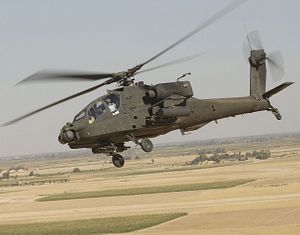The U.S. Department of Defense announced on Monday that it will station an Apache attack helicopter squadron and artillery division headquarters permanently in South Korea in a bid to deter threats from China and North Korea in the region.
Mara Karlin, acting deputy undersecretary of defense for policy, said that the department had concluded its Global Posture Review (GPR) and added that President Joe Biden had approved Secretary of Defense Lloyd Austin’s findings and recommendations from the GPR. The main focus of the GPR is analyzing the capability of the U.S. troops in allied countries and making decisions on how to manage troop levels to counter the threats from adversaries.
“Consistent with the Secretary’s focus on China as our pacing challenge, the priority region for the Global Posture Review was the Indo-Pacific,” Karlin said in a press briefing. She also said that the GPR is advancing initiatives to contribute to regional stability and deter “military aggression from China and threats from North Korea.”
Seoul’s Defense Ministry welcomed the Pentagon’s GPR announcement, describing it as evidence of the importance of the South Korea-U.S. alliance.
Along with the permanent stationing of Apache helicopter unit and artillery headquarters in South Korea, the Pentagon will keep about 28,500 U.S. troops stationed in South Korea, the third-largest U.S. military presence outside of the United States. Some experts in Seoul had predicted that the Biden administration might reduce the troop numbers of United States Forces Korea after the U.S. House Armed Services Committee passed the latest defense authorization bill in early September. The bill removed a clause that stipulated a lower limit for U.S. troops on the Korean Peninsula. Likewise, the Senate Committee on Armed Services also submitted a defense budget bill that did not specify the minimum number of troops assigned to United States Forces Korea in late September, implying that the U.S. could reduce the number of troops in South Korea over the coming years.
However, the Pentagon has reaffirmed that the number of troops in South Korea will be effective in countering the North’s threat. Washington also reiterated that there would be no changes regarding the U.S. nuclear umbrella policy for South Korea, which aims to deter a North Korean nuclear attack.
The U.S. seems to approach Korean Peninsula issues using the philosophy of responding to “force with force, and to goodwill with goodwill” – the very words that North Korean leader Kim Jong Un once aimed at South Korea and the United States.
“The U.S. upgrading rotational deployments to permanently stationing an Apache helicopter unit and artillery brigade headquarters in South Korea signals to Pyongyang that Washington is committed to its ally’s defense,” Leif-Eric Easley, associate professor of international studies at Ewha Womans University in Seoul, told The Diplomat. “This [move] also reminds China that Seoul is supportive of a robust U.S. force posture in Asia that contributes to regional security and stability.”
“The Biden and Moon administrations want to resume dialogue with Pyongyang and cooperate with Beijing on North Korea, but the Kim regime is unwilling to even engage regarding humanitarian assistance, much less denuclearization talks,” Easley added.
To respond to North Korea’s nuclear threat, some hawkish conservatives in both South Korea and the United States have pushed U.S. government to redeploy tactical nuclear weapons to the South or introduce NATO’s nuclear sharing in the country. Both the U.S. and South Korean governments, however, have indicated that this option is off the table.
The U.S. secretary of state and South Korean defense minister will be having the annual Security Council Meeting (SCM) this week in Seoul to discuss regional and alliance issues, including North Korea, an end-of-war declaration, the transfer of wartime operational control (OPCON), and the status of the South Korea-U.S. military alliance. The two countries have been discussing the transfer of wartime OPCON from the U.S. to South Korea for more than a decade, but the timeline for the transfer has been postponed due to the North’s provocations and growing missile programs.
There is a three-stage program in place for testing the operational capability of South Korea, but the country has not yet conducted the second stage of the program – a full operational capability (FOC) test – due to the pandemic. The first stage of the program – initial operational capability – was completed in 2019. South Korea and the U.S. agreed on Thursday to conduct the FOC test in 2022 and update a war plan to deter North Korea’s advanced nuclear and missile programs. The countries have set the mid-2020s as a rough timeline for OPCON transfer, but Seoul has been working to push it ahead. Moon urged the Defense Ministry to take over wartime operational control “as soon as possible.”
In the meantime, Suh Hoon, director of the National Security Office at the presidential Blue House, will this week visit China to have a meeting with Yang Jiechi, the top Chinese foreign policy official, and discuss regional issues. The discussions with both the U.S. and China are a sign that there could be productive progress on Moon’s last attempt to make progress on his peace process, as the countries involved in an end-of-war declaration have been in active consultations for the last three months.

































